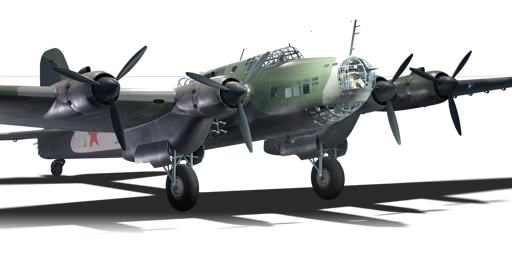



The Petlyakov Pe-8 was an early design Soviet heavy bomber which debuted in 1936. This monster of a bomber was the only four-engine bomber produced by the Soviet Union during World War II. Though impressive as it was, it was only produced in limited numbers and was reserved for special occasions called "morale raids" to encourage and raise the spirits of the Soviet population by hitting important German targets deep behind enemy lines to include bombing Berlin in mid-1941. Other prime targets included the nighttime bombing of factories, German airfields and rail yards. As such an important aircraft to the Soviet people, it became a priority target for the German Luftwaffe pilots to go after. By 1944, all remaining Pe-8s were removed from service but were retrofitted for other jobs such as VIP transport and operations up into the Arctic Circle.
The Pe-8 was introduced in Update 1.53 "Firestorm". Though a large and tempting target, it is not without its merits. The huge bomber has a nose gunner, tail gunner, rear-facing dorsal turret and two rear-facing underwing gun pods. Attacking this aircraft especially from the rear whether above, below or directly from the rear is a bad choice as, like with the BV 238, there are many defensive guns which can hit and hit hard. These defensive weapons are critical to protecting the bomber against inbound enemy fighters, especially because of the bomb payload which it can carry. Options can range between 2,000 and 5,000 kg bomb loads with as many as 40 x 50 kg or 100 kg bombs, or fewer but heavier bombs such as 6 x 500 kg bombs or a single massive 5,000 kg FAB-5000 bomb. The diverse payload options present a wide range of potential targets for the Pe-8, from clearing bases and detonating battleships, to carpet bombing ground defences and clusters of lighter vehicles.
flaps
flaps
flaps
brake
| Belt | Belt filling | Armor penetration (mm) at a distance: | |||||
|---|---|---|---|---|---|---|---|
| 10 m | 100 m | 500 m | 1000 m | 1500 m | 2000 m | ||
| FI-T/HEF | 4 | 4 | 4 | 4 | 4 | 4 | |
| AP-I/FI-T/AP-I | 28 | 24 | 14 | 7 | 4 | 2 | |
| AP-I/FI-T/HEF/HEF-I | 28 | 24 | 14 | 7 | 4 | 2 | |
| Belt | Belt filling | Armor penetration (mm) at a distance: | |||||
|---|---|---|---|---|---|---|---|
| 10 m | 100 m | 500 m | 1000 m | 1500 m | 2000 m | ||
| T/AP/AP/IAI | 32 | 30 | 22 | 15 | 11 | 7 | |
| API-T/AP/AP/AP-I(c) | 34 | 32 | 24 | 17 | 12 | 8 | |
| API-T/AP-I | 29 | 27 | 20 | 13 | 9 | 6 | |
| Belt | Belt filling | Armor penetration (mm) at a distance: | |||||
|---|---|---|---|---|---|---|---|
| 10 m | 100 m | 500 m | 1000 m | 1500 m | 2000 m | ||
| T/Ball/Ball/AP-I/AI | 13 | 12 | 7 | 3 | 2 | 0 | |
| AP-I/AP-I/AP-I/API-T | 13 | 12 | 7 | 3 | 2 | 0 | |
| API-T/API-T/API-T/AI | 9 | 8 | 6 | 3 | 0 | 0 | |












Flight performance | |
|---|---|
Survivability |
|---|
Weaponry | ||
|---|---|---|